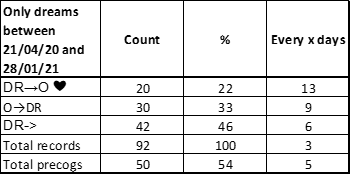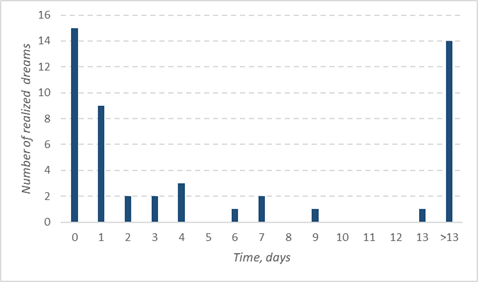Precognitive statistics
by Steve Randolf, PhD
Here are some statistics from the first nine months of operation of my online precognitive dream database. (Edit: Unfortunately I had to remove the database after a total of 3.5 years of operation due to a diversity of issues).
During the period from 21/04/20 and 28/01/21 or 282 days, I recorded 360 dreams in my dream diary (1.3 per night on average), of which I copied only 92 in the database (i.e. about 1/4th of all). 54 % of them, i.e. 50 dreams turned out to be precognitive ones, which is equivalent to one precognitive dream every 5 days. I had recorded 20 of these 50 dreams before the outcome (marked with DR→O ❤ in the database, DR standing for dream record, and O for outcome), while I recorded the other 30 after it (marked with O→DR).

There are two main reasons for this: I did not identify some of the dreams as precognitive ones before the outcome; others I did identify but did not record on time (before the outcome), partly because some dreams came true the same day after the dream. The following graph shows the number of dreams that came true after 0, 1, 2 and so on up to 13 days. As can be seen, the most frequent dream-outcome span is 0 days, followed by one day. After that, the probability of having an outcome appears to drop significantly, although quite a few (10) dreams have come true even after 3-6 months (comprised within the last bar, marked ">13 days").

Although these numbers might look extraordinary to many people, they are actually not. Bruce Siegel reported in his book Dreaming the Future that one out of every four of his dreams had come true. Moreover, according to his estimations, on average about 40 % of his precognitive dreams came true within an hour of his waking up! Other books like An Experiment with Time by British aeronautical engineer John William Dunne and The Oneironauts by NASA astronomer Paul Kalas also suggest a very significant frequency of dream precognition. In fact, Kalas reported an average of 37 deja vu experiences throughout a period of 8 years with a peak of 56 such experiences in one particular year. That last number is equivalent to 1 precognitive dream every 6.5 days, a result very similar to mine. Clearly, having at least one precognitive dream per week is something normal if one pays attention to his/her dreams and keeps a dream diary.
As to the topics of my dreams over these 9 months, there has been quite a lot of variety, covering coronavirus issues, natural disasters, fires, accidents, injuries, technology, art, and even TV cartoons. This is good news for the people who dread precognitive dreams believing they are all about death and disasters.
Published: 2021-02-14


